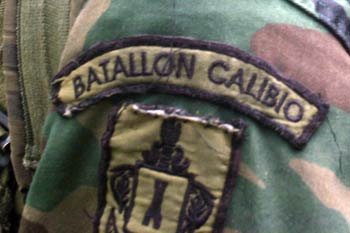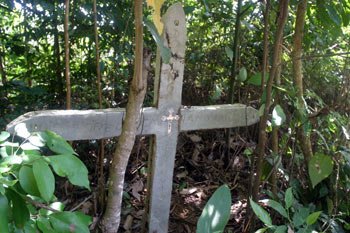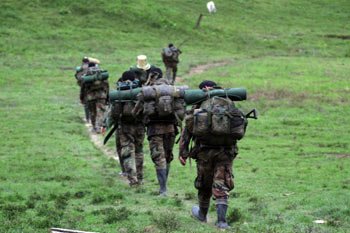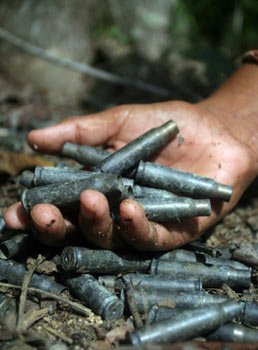


Colombian Military Attacks Campesinos
Paramilitaries Continue to Be a Key Arm of the Colombian Government
By Ramón Acevedo
Special to The Narco News Bulletin
November 14, 2005
NORTHEASTERN ANTIOQUIA, COLOMBIA: “Here in the region we are living with the severe violence of the military and the paramilitaries,” stated a peasant-farmer who did not wish to give his name. He continued, “At the moment we are being harassed by the military battalion ‘Demolisher Platoon No.1, Calibio Battalion of the 14th Brigade’, which is under the command of Sergeants Setina and Blanquiceth. The Battalion members present themselves as official military and then the next minute they change their armband and are the paramilitaries. Lately they have been detaining, intimidating, torturing, and assassinating local campesinos (peasant farmers) and community leaders.”
 Photos D.R. 2005 Ramón Aceveda |
The Colombian military continuously uses the tactic of killing campesinos, dressing them in camouflage, and denouncing them as insurgency. A member of Sigifredos family stated, “The Calibio Battalion came to the house at six in the morning, they grabbed him, tied him up and demanded to know where the guerrilla camps were. But he knew nothing of the sort. He was in shorts, a t-shirt, and some rubber boots when they took him. At 8 in the morning, about 100 meters from the house we heard machine gun fire. When the military left at 4pm we saw them taking his dead body dressed in camouflage.” Members of the Battalion Calibio have been confirmed by various campesino sources to work with and actually operate as paramilitaries.
 Memorial to Luis Sigifredo Castaño near the site of his assassination. |
After many years of international and national pressure to abide by international human rights, the Colombian government continues to use the military and paramilitary “death squads” as main weapons against the civilian population and political opposition. For decades, the Colombian military and their paramilitary allies have enjoyed a high level of impunity from judicial processes. Most recently, on October 23rd the head of Colombia’s secret police (DAS), Jorge Noguera, resigned after the discovery of tapes discussing the agency’s alleged plans to give intelligence information to the paramilitaries. In addition, the paramilitaries have boasted many times of how they control more than 35 percent of the Colombian congress.
 Soldiers of the Calibio Battalion on the march in Antioquia. |
The law has been widely criticized for letting the country’s worst human rights abusers off the hook while doing nothing to truly dismantle paramilitary networks that continue to operate. New paramilitary groups have even been reported to have emerged since the law’s passage. Nevertheless, the law received great support from the U.S. State Department before and after its passage, and recently received an endorsement from the European Union.
It is also important to note that the 40-year-old Colombian civil war is exacerbated by increasing military aid from the United States. Since 1999, when Plan Colombia was signed, over $4 billion U.S. dollars have been funneled into the police and military of Colombia. Meanwhile, human rights abuses by the government forces and their paramilitary allies have increased significantly. Nevertheless, as recently as August the State Department was “certifying” Colombia on human rights, and the foreign aid law the U.S. Congress passed last week continues to supply Colombia with more military aid than any country outside of the Middle East.
 Common sight in rural Colombia: piles of spent shell casings on the ground. |
In response, campesinos from northeastern Antioquia have created social organizations, such as the ACVC and CAHUCOPANA, to protect their rights, and to create socio-economic projects to help the people of the region. These organizations have set up projects dealing with housing, food, education, health, documentation of human rights violations, and protection of their communities. Since their creation, however, both of these organizations have been violently attacked by the government and the paramilitaries.
In an interview a leader of the ACVC stated, “To the citizens and social organizations of the United States we ask that you stand in solidarity with the Colombian campesino. Military, economic, and political intervention by your government has been devastating to our people. Your neo-liberal economy does nothing but take from the mouth of our children. Your helicopters, weapons, and troops support an oppressive, violent government.”
- The Fund for Authentic Journalism
For more Narco News, click here.




